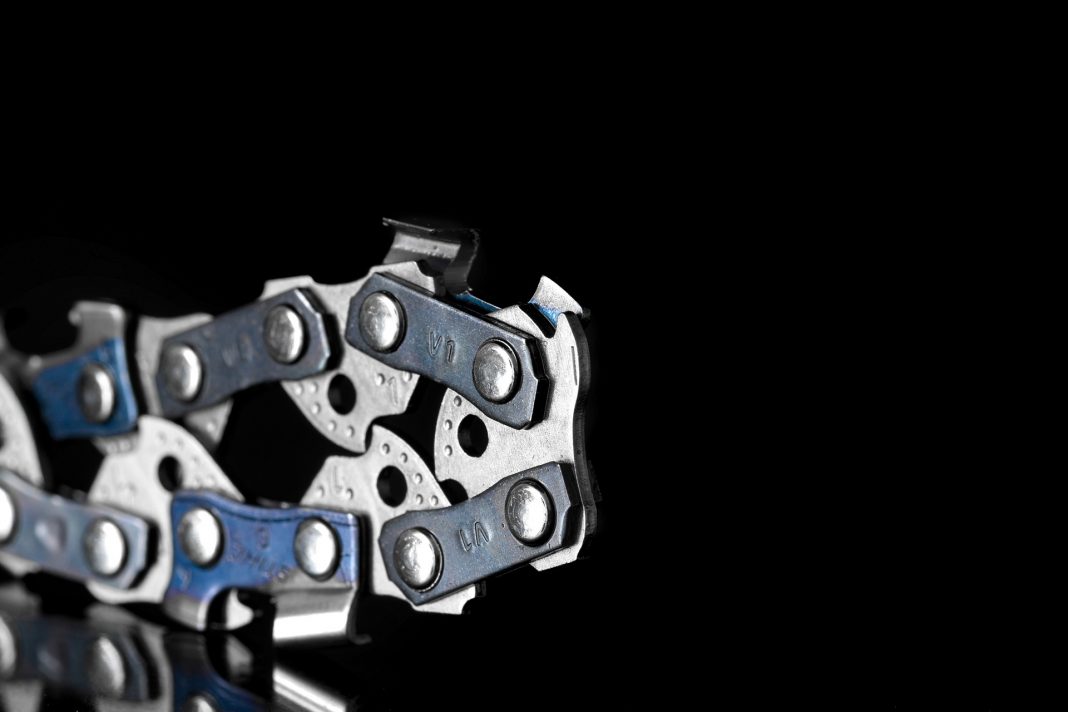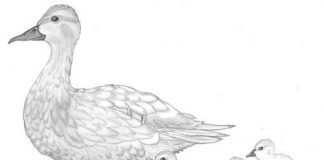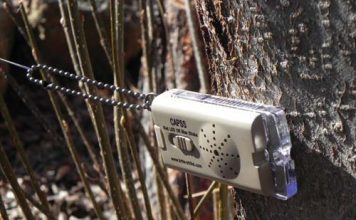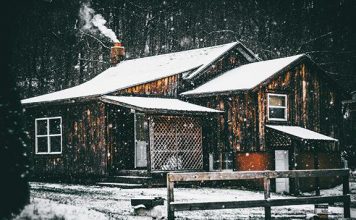| Issue #39 • May/June, 1996 |

Milling a board with a chainsaw lumber-maker.

Figure1: The pieces.

Beams, joists and walls were made with a chainsaw mill.

Figure 2: The frame.

Figure 3: The surface to which the chainsaw bar is bolted.

Figure 4: The assembled mill frame is bolted to the chainsaw bar.

Figure 5: Muffler clamps hold settings to determine thickness of boards.

Figure 6: The metal-edged starter board makes the first cut flat and straight.

Starterboard, chain and mill.

Guiding the lumber-maker through a cut.
These are trying times for those of us who need to buy lumber. The prices of good boards are at an all-time high. The E.P.A. is shutting down the mills that make plywood. The timber companies have less old growth forest to choose from. Most of the affordable timber is being cut from new-growth pine. In the Midwest, the standard 2×4 is made primarily from spruce. Boards made from cherry, oak, or poplar are expensive. The easy solution to this lumber crisis is for the woodworker to make his own boards from the trees of his choosing.
There are many methods for making boards from trees. Most of them require costly equipment or contracting out the work. The portable sawmills that will make boards in the back yard cost several thousand dollars. If the back-yard woodsman chooses to cut down his own trees and send them off to the mill, transporting the trees to the mill and bringing the finished boards back home is expensive.
The affordable and practical solution for the carpenter who needs lumber is to make his own boards at home with his chainsaw. With a large saw and a special device fitted onto the chainsaw bar, any kind of board can be made for just pennies. This device, known as a chainsaw lumber-maker, will mill through any tree, no matter how large or tough, making boards of any length or thickness.
The construction of a chainsaw lumber-maker requires a bit of steel and pipe and a few bolts (Figure 1). To make the mill, a rectangular frame, slightly shorter than the length of the chainsaw bar, is welded together from square and channel steel stock.
Once the frame is welded, two recesses need to be ground into the centers of the channel stock pieces which make up the two short sides of the rectangle (Figure 2). In these recesses, two pieces of half-round pipe are welded into the channel stock. These half-round pieces will act as sleeves to accept the two pieces of whole round pipe. The round pipe will be adjusted up and down according to how thick the miller wants his board.
Next, two short pieces of square tubular stock are welded onto the ends of the whole round pipes. These short pieces should be four inches longer than the width of the chainsaw bar. To make the square stock stronger, reinforce it by welding a 3/8″ steel plate onto the center of the underside of the short square tubular stock. Then, from the center line, measure an equal distance out from both sides and drill holes using a 5/16″ drill bit to provide for a 3/8″ tap and bolt size. Drill through the plates and the one side of the square stock as shown in Figure 3. These pretapped steel plates will act as the bolting surface for the chainsaw’s bar.
In order to bolt the welded frame onto the bar, remove the chainsaw’s body from the bar. Drill four holes, two on each end of the bar, centered to match the pretapped holes on the reinforced square tubular stock. Bolt the mill onto the chainsaw bar through these reinforced holes by using four 3/8″ machine bolts. Then lower the rectangular frame onto the round pipe which is welded onto the short square tubular stock which is now bolted onto the bar. With the mill bolted onto the bar (Figure 4), the bar is put back onto the chainsaw body.
The rectangular frame can now be adjusted up and down to set the thickness of the milled board. To make these adjustments, two muffler clamps, one above the other, are placed around the half round and the whole round pipe (Figure 5). To set the correct measurement for the sleeves, measure from the chainsaw bar to the part of the rectangular frame that rides against the log (Figure 4). By loosening the clamps, the round pipe can be moved up or down to adjust the board thickness. Once tightened, the clamps will keep the pipe from moving up and down while milling. This enables the miller to make boards of uniform thickness.
Note: Not all chainsaws are suitable for a mill attachment. The chainsaw engine must be at least five cubic inches. The style of the saw must be such that it can be refueled in the milling position, with the bar parallel to the ground. The saw must have a 30″ bar or longer. The longer the bar, the wider the boards that can be milled. A 36″ bar will mill boards 24″ wide. The chain must be chisel style and be ground square with a hook angle of 40 to 50 degrees.
Before lumber-making can begin, one side of the tree to be milled will need to be made flat. This initial cut is different from all subsequent cuts, because the mill must first have a flat surface to rest on. This beginning cut is made with a starter board.
A starter board is a board at least ten feet long with steel sides running the length of both sides of the board (Figure 6). The length of the starter board determines the length of the boards that can be milled. A ten-foot starter board is the best length for most situations. The board is two inches thick, and the channel iron running the length of it will act as a guide for the mill to be pushed along. Once the initial cut is made, the top surface of the log will be flat, and the starter board won’t be needed again until a new log is started.
A starter board will last for years. If three or four ten-foot starter boards are made, they can be set end to end and a 30- or 40-foot tree can be milled, providing lumber long enough to make beams. With the chainsaw lumber-maker, any length board is possible, as long as that same length of starter board (or boards) is available.
To mill lumber, the chainsaw is started and then laid horizontally either against the starter board or the flat surface of the log. The bar is guided carefully into the log’s end as the cut begins. The saw will be easier to guide through the log if the tree slopes slightly downhill away from the miller. The mill only needs to be steadied and pushed gently until it reaches the end of the cut. At the log’s end, the throttle is released and the chain eased out.
When milling softwoods, board production is fast. Twenty pine or poplar boards can be milled before lunchtime. With dense trees like locust or elm, milling goes a bit slower, and the chain will need to be resharpened more often. Yellow poplar is a great choice for backyard lumber-making, as it is a soft hardwood, and its variegated colors make it a superior choice for woodworking projects. Since poplar grows quick, tall, and straight, it has enough strength to carry stress loads, yet mills easily.
Boards milled with a chainsaw lumber-maker are smooth and do not need to be planed. Freshly-milled boards are stacked 20 tall with a one-inch air gap between boards. For the highest quality lumber, the boards should be kept under cover and away from excessive moisture. Lumber made from dead trees can be used in two weeks. Green wood needs to cure at least three months. If the boards are intended for flooring, they can easily be tongue-and-grooved by using a dado cutting blade on the table saw.
The lumber-maker frame itself requires no maintenance. The saw chain needs to be kept sharp, and it will be over seven feet long, so chain sharpening is the most tedious part of lumber-making. The chain will need to be sharpened after every eight hours of milling, and a new chain bought after every 5,000 board feet milled. If the trees to be milled are dragged home in the dirt, the chain will get dull much faster.
The mill is potentially quite dangerous. Good safety measures during its operation are important. Besides the need for safety glasses and ear protection, the miller must never become distracted or take his attention from the mill. Seven feet of rapidly moving saw chain can be lethal.
Once the woodworker owns a chainsaw lumber-maker, he will never need to buy lumber again. Houses can be built from the substructure to the roof just from the trees in the back woodlot. If 12-inch-wide roof beams or 4×4 posts for footings are needed, the lumber-maker can mill two or four sides off of a tree by moving the starter board. Logs can be milled flat on two sides to make tight-fitting walls for a log house, leaving less space to be filled in with chinking.
Milling boards from the back yard is great for the environment: it recycles unwanted or dead trees, and trees can be cut out selectively, allowing smaller trees to fill in the open areas without clear-cutting an entire forest. Trees that might have been left to rot can be milled into beautiful lumber.
With the chainsaw lumber-maker, the carpenter has unlimited choices of species and size of boards for his projects. The days of picking through crooked, inferior boards at the lumberyard will be over. And no more sticker shock at the cash register over a pile of 2x4s. Backyard lumber-making will save the woodworker hundreds of dollars and allow his creativity to soar.














